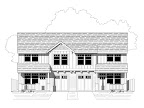A while back we posted a series on the mechanics of calculating the heat load of your home. At the end we promised to offer up an Excel file that is set up for you to do your own calculations without getting a headache or hand cramp
The calculator comes pre-filled with info from our Houston 2448. Everything in light yellow can be modified. The file or the rest of the cells are not locked. This should be considered open-source, AKA modify at your own risk. If you enter any values into white cells, you may destroy formulas. There are also no fail safes or error checking in here. Double check your work.
There are 7 components listed: slab, floor, walls above and below grade, windows, doors, and roof. Each of these has inputs for area and R-value. Note that windows should be input as U-value. When inputting wall area, don't take windows or doors into account. They are automatically deducted from the wall area in the calculations. Outside design temperature can be modified for the first four items; remaining values are derived from those.
All the work is shown on the following columns. The UA value, Δt and Btu/hr values are shown. Indoor temp can be changed to your desired setpoint. To the right is a little table with all sorts of nerdy calculations in it. Percent of load tells you which component is losing the most heat. Cost/hr tells you how much it costs. In the example you can see that more than half the heat loss in this house is through the walls. Of course! There is only R-15 in the walls! You can also see that increasing to R-21 doesn't do much for that factor. Increase the walls to R-30 and you can get that component down to about 1/3 of the heat load. Still high. Note that the rest of the load percentages change as you change the area or R-value of an item.
Lower down on the page is a place to take leakiness of the house into account. Input your target or measured ACH50 as well as volume of the home. You should only change the HC if you know what you're doing.
The final input is for number of bedrooms or potential bedrooms. This little calc will determine internal gains from humans. It takes the number of bedrooms and adds 1 person per ASHRAE standards. If there will only be two people living in your 3000sf house, enter one bedroom for kicks.
Total peak heating load is given near the bottom of the sheet. The final table gives an idea of how much of what types of heat is needed to keep the house comfortable. A forced air unit size and efficiency can be entered. As you can see, even this is WAY too big for the house. Even 2 1kW cadet heaters will do fine. In this case we would recommend a 500W heater in each of the bedrooms and bathrooms with a 1kW in the great room. Still a bit much but at least reasonable. Perhaps a mini-split heat pump would do for efficiency as well as adding some cooling if you are in the South.
This calculator should be used for entertainment purposes only. No guarantees about the results or performance of this tool are made or implied. If you break it, you bought it. If you find errors, please feel free to let us know. If somebody who knows javascript is bored, we would be thrilled to turn this into an online tool.
Tuesday, December 20, 2011
Subscribe to:
Post Comments (Atom)






No comments:
Post a Comment